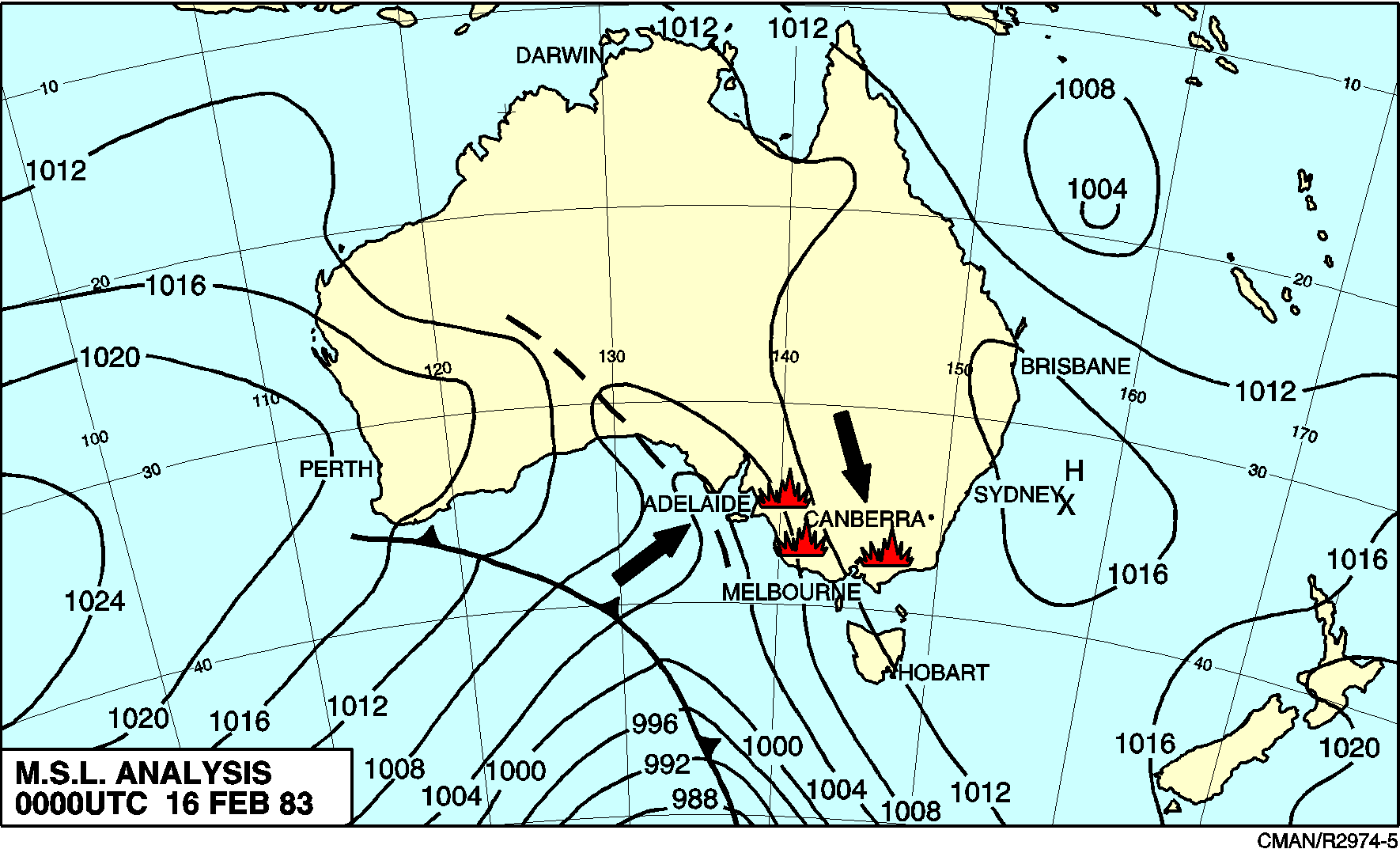|
E. Linacre |
4/'99 |
![]()
Bushfires are a common scene in southeastern Australia following a period of drought. A typical dangerous fire situation occurs when a vigorous cold front approaches a slow-moving high in the Tasman Sea, advecting hot, dry, northwesterly winds from the interior desert towards the southeast (Fig 1).

Fig 1. Synoptic analysis of 16 February 1983, the day of the Victorian Ash Wednesday bushfires which killed 71 people and destroyed a lot of property. Several months of El Niño-related drought preceded these fires (1).
The Forest Fire Danger Index
Forest fires are more likely when the soil is dry and when a lot of forest fuel (e.g. tonnes of wood per square km) is available. Once a fire has started (e.g. by lightning), the main atmospheric variables that determine the size and longevity of this fire in drought-stricken bush are:
An index is used in Australia to assess the likelihood and severity of bushfires. This index, the Forest Fire Danger Index (FFDI), was empirically derived by McArthur and equals the following (1):
FFDI = 1.275 D 0.987 exp{[T / 29.5858] - [H / 28.9855] + [V / 42.735]}
where D is a drought factor:
D = 0.191[I + 104][N + 1]1.5 / {3.52 [N + 1]1.5 + R - 1}
T is the daily maximum temperature (° C), H is the daily minimum relative humidity (%), V the daily-mean wind speed (km/h), N is the number of days since the last rain, R (mm) is the total rain in the most recent 24 hours with rain, I (mm) is the amount of rain needed to restore the soil's moisture content to 200 mm.
The dependency of the FFDI on the drought factor (i.e. the rain history) is about linear, but the FFDI increases exponentially with wind speed and temperature. Of the many parameters in the FFDI, the dryness of the air the main one: the annual sum of daily values of FFDI at Sale in Victoria in southeast Australia proves to relate very well to Ha, the annual mean of the daily values of H (%): S FFDI @ 8603 - 124.1 Ha. A corollary of this is that reductions of H resulting from doubling the atmosphere's carbon dioxide content will increase the danger of bushfires (2).
The connection between the FFDI and the occurrence of bushfires in practice has been established by considering 28 years of 3pm daily data at Melbourne (3). There was a strong linear correlation between the Melbourne FFDI and the logarithm of the frequency of bushfires in the surrounding state of Victoria during the bushfire season of November to March. However, the numbers depend also on the day of the week, the amount of forest litter as fuel on the ground and the occurrence of lightning. Of the average of 2.46 bushfires/day, 0.75/day were triggered by lightning. The others were sparked by people or by another bushfire nearby. The importance of accidental ignition is obvious when comparing the average of 3.35 fires/day on Sundays against only 1.87/day on weekdays, when fewer people make outings into the forests. Analysis also revealed that the previous day's FFDI influenced the frequency of fires starting. Also, bushfires did not happen if the fuel amounted to less than 8 tonnes/hectare, but could become uncontrollable on the approximately 100 days annually when the fuel exceeds 30 t/ha.
Note that the FFDI should not be used to assess forest fire danger on other continents, e.g. North America.
References